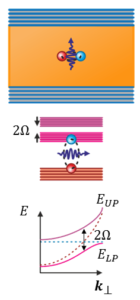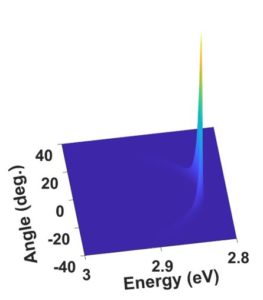Strong light-matter coupling
 Strong light-matter coupling is an exciting emerging field in condensed matter physics and photonics. When light is incident on semiconductors, it is absorbed leading to the generation an electron-hole pair called an exciton. Excitons can then emit photons. In photonically confined structures such as microcavities light can be trapped for up to tens of picoseconds, increasing the interaction time with the light-emitting material. This increases the strength of coupling between excitons and photons to form hybrid states called cavity polaritons enabling observation of exciting phenomena such as polariton condensation – an analogue of Bose-Einstein condensation. Usually this occurs at low temperature, but because organic semiconductors have strongly bound excitons at room temperature, these effects can be studied – and used – at room temperature. This makes low threshold polariton lasing, room temperature polariton condensation and applications in quantum computing possible.
Strong light-matter coupling is an exciting emerging field in condensed matter physics and photonics. When light is incident on semiconductors, it is absorbed leading to the generation an electron-hole pair called an exciton. Excitons can then emit photons. In photonically confined structures such as microcavities light can be trapped for up to tens of picoseconds, increasing the interaction time with the light-emitting material. This increases the strength of coupling between excitons and photons to form hybrid states called cavity polaritons enabling observation of exciting phenomena such as polariton condensation – an analogue of Bose-Einstein condensation. Usually this occurs at low temperature, but because organic semiconductors have strongly bound excitons at room temperature, these effects can be studied – and used – at room temperature. This makes low threshold polariton lasing, room temperature polariton condensation and applications in quantum computing possible.
Hybrid Polaritonics, an EPSRC project (EP/M025330/1), is an ongoing collaboration between experimental and theoretical groups specialised in inorganic, organic as well as hybrid semiconductor materials for strong light matter coupling studies from the Universities of Southampton, Sheffield, St Andrews, and Würzburg.
Low-threshold room temperature polariton lasing
As mentioned above, organic semiconductors can strongly couple to light at room temperature. However, room temperature polariton lasing and polariton condensation has been reported in very few organic semiconductor materials. In our group, we have extended the range of materials by demonstrating polariton lasing in microcavities containing fluorene-based oligomer[1] and polymer[2]. We have shown that these materials give the lowest threshold for polariton lasing (in terms of incident power) in an organic semiconductor by an order of magnitude. These results bring current research closer to electrically pumped polariton devices.

Our lab is equipped with complete state of the art facilities including a RF sputter deposition and multiple source thermal evaporators for fabrication in a class 10000 cleanroom with. Measurements are made using fluorimeters, streak cameras and transient absorption for photo-physical studies and femtosecond lasers, Fourier imaging spectroscopy and interferometry for spatial, spectral and angle-resolved lasing studies.